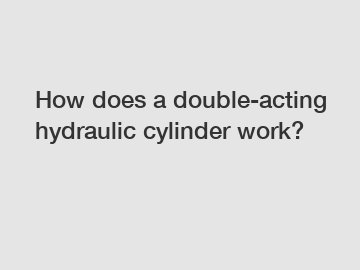How does a double-acting hydraulic cylinder work?
How does a double-acting hydraulic cylinder work?
Hydraulic cylinders play a crucial role in various industries, enabling heavy machinery and equipment to perform their tasks efficiently. Among the different types available, double-acting hydraulic cylinders are widely used due to their unique design and functionality. In this article, we will delve into the working principles of double-acting hydraulic cylinders, exploring their components and the processes involved. So, let's dive right in!
A double-acting hydraulic cylinder is a device that converts hydraulic power into linear mechanical force and motion. Unlike single-acting cylinders that exert force in one direction, double-acting cylinders provide force in both the extending and retracting strokes. This ability allows for more versatile and precise control over mechanical systems.

2. Components of a Double-Acting Hydraulic Cylinder:
a. Cylinder Barrel: The cylinder barrel serves as the main body, housing the other components. It is typically made of high-strength steel or other durable materials, capable of withstanding high pressures.
b. Piston: The piston is a movable component within the cylinder barrel. It divides the cylinder into two chambers, each connected to a hydraulic port. The piston's sealing arrangement ensures minimal leakage between the chambers.
c. Rod or Stem: The rod, also known as the stem, attaches to the piston and extends outside the cylinder barrel. It transmits the force generated by the hydraulic fluid to the external load.
d. Hydraulic Ports: Double-acting hydraulic cylinders have two hydraulic ports – one for the extension stroke and the other for the retraction stroke. These ports connect to the hydraulic power source and control valves.
3. Working Principles of a Double-Acting Hydraulic Cylinder:
a. Extension Stroke: When hydraulic pressure is applied to the port connected to the rear chamber, it pushes the piston, rod, and external load forward. Simultaneously, the hydraulic fluid from the front chamber flows back into the reservoir or returns to the hydraulic pump.
b. Retraction Stroke: To retract the cylinder, hydraulic pressure is applied to the port connected to the front chamber. This pushes the piston, rod, and load backward, while the fluid from the rear chamber returns to the reservoir or pump. The backward movement of the piston compresses the fluid in the front chamber.
4. The Role of Hydraulic Fluid:
Hydraulic fluid plays a crucial role in the operation of a double-acting hydraulic cylinder. It is the medium that transfers force and motion from the pump to the cylinder. Specialized hydraulic fluids are used as they possess excellent lubricating and sealing properties, ensuring smooth operation and minimizing wear and tear.
5. Controlling the Hydraulic Cylinder:
To precisely control the extension and retraction strokes of a double-acting hydraulic cylinder, a control valve or directional control valve is used. This valve determines the flow path of the hydraulic fluid, enabling operators to direct the cylinder's movement as required for their specific application.
6. Applications of Double-Acting Hydraulic Cylinders:
Double-acting hydraulic cylinders find widespread use in various industries and applications, including:
- Construction and infrastructure: Excavators, cranes, bulldozers, and backhoes utilize hydraulic cylinders for lifting, digging, and moving heavy loads.
- Manufacturing and automation: Hydraulic cylinders are employed in presses, injection molding machines, and robotic systems to generate precise force and control movement.
- Aerospace and aviation: Landing gear systems and control surfaces in aircraft rely on double-acting hydraulic cylinders for smooth and reliable operation.
- Automotive: Brake systems, suspension components, and convertible roof mechanisms often incorporate hydraulic cylinders.
7. Advantages of Double-Acting Hydraulic Cylinders:
- Bidirectional force: The ability to exert force in both extension and retraction strokes enhances functionality and control of mechanical systems.
- Precise operation: Hydraulic systems offer precise positioning, allowing for accurate movements, load manipulation, and control.
- High durability: Double-acting hydraulic cylinders are designed to withstand heavy loads and extreme conditions, ensuring longevity and reliability.
In conclusion, double-acting hydraulic cylinders are essential components of various machinery and equipment, enabling precise force generation and control. By harnessing the power of hydraulic fluid, these cylinders facilitate efficient and reliable operation in industries ranging from construction to automotive. Understanding the working principles and components of double-acting hydraulic cylinders is vital for engineering professionals and anyone looking to grasp the fundamentals of hydraulic systems.
Are you interested in learning more about customized long stroke hydraulic cylinder manufacturer, CNC Skiving Roller Burnishing Machine Supplier, one way hydraulic cylinder manufacturer? Contact us today to secure an expert consultation!


Comments